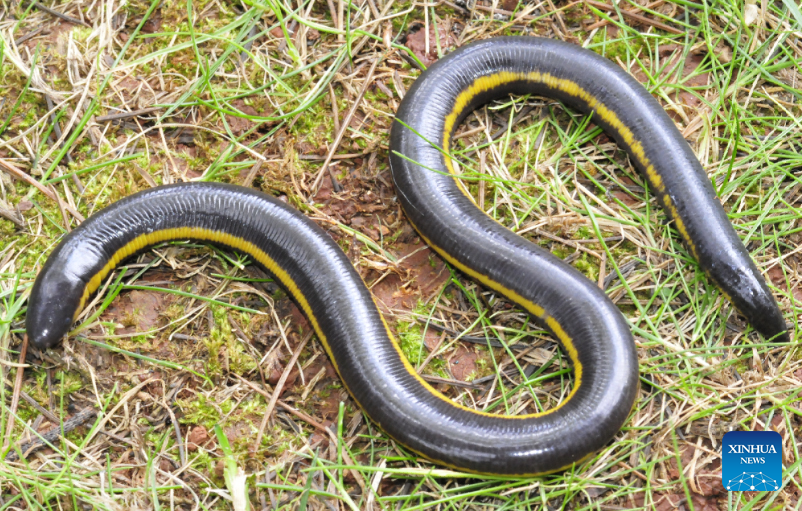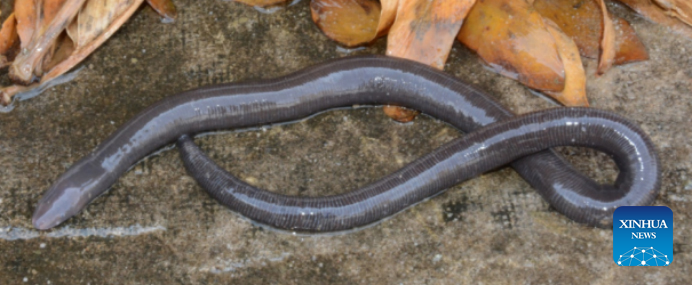
This undated photo provided by the Kunming Institute of Zoology under the Chinese Academy of Sciences (CAS) shows a specimen of the Xishuangbanna caecilian, the first species of caecilian found in China. Researchers at the Kunming Institute of Zoology under the Chinese Academy of Sciences have discovered a new species of caecilian, the second such amphibian species found in China. The newly-identified species, which was named Yang's caecilian or Honghe caecilian, was documented in Honghe Hani and Yi Autonomous Prefecture, southwest China's Yunnan Province. (The CAS Kunming Institute of Zoology/Handout via Xinhua)
BEIJING, Jan. 8 (Xinhua) -- Researchers at the Kunming Institute of Zoology under the Chinese Academy of Sciences have discovered a new species of caecilian, the second such amphibian species found in China.
This discovery enriches China's biodiversity and provides valuable insights for further understanding the evolution of amphibians, the Science and Technology Daily reported on Wednesday.
The newly-identified species, which was named Yang's caecilian or Honghe caecilian, was documented in Honghe Hani and Yi Autonomous Prefecture, southwest China's Yunnan Province. The findings were recently published in the journal Asian Herpetological Research.
Currently, the new species has only been discovered in a very limited area within the Jinping County of Yunnan Province, and its population is extremely sparse.
Therefore, immediate efforts for the strict protection of its population and habitat are deemed urgent, said the researchers.
The limbless Caecilian, as one of the earliest groups of vertebrates to inhabit land, may look like worms or snakes with small eyes. They hold significant importance in biological classification.
However, caecilian species are relatively rare among existing amphibians. There are nearly 200 species of caecilians known to science.
Prior to this discovery, China had only recorded one species of caecilian -- the Xishuangbanna caecilian, first discovered by Yang Datong, China's prestigious zoologist specializing in amphibian study, in 1976. It is primarily distributed in Yunnan, Guangxi and Guangdong.
Jinping, a region rich in biodiversity, had not reported the discovery of caecilians before.
After extensive efforts, researchers finally found caecilians in the county in 2004, whose morphology, however, differed significantly from that of the Xishuangbanna caecilian.
Further research confirmed that this caecilian represents a previously unknown species.
The naming of Yang's caecilian pays tribute to Yang Datong for his contribution in the discovery of caecilian species in China, and establishes a comparative relationship with the Xishuangbanna caecilian, according to the report.
While both belong to the same taxonomic class of caecilians, the Honghe caecilian is notably distinct, lacking the light yellow longitudinal stripes characteristic of the Xishuangbanna caecilian. ■

This undated photo provided by the Kunming Institute of Zoology under the Chinese Academy of Sciences (CAS) shows a specimen of the newly-discovered species of caecilian in Jinping County, southwest china's Yunnan Province, the second such amphibian species found in China. The newly-identified species, which was named Yang's caecilian or Honghe caecilian, was documented in Honghe Hani and Yi Autonomous Prefecture, southwest China's Yunnan Province. (The CAS Kunming Institute of Zoology/Handout via Xinhua)



